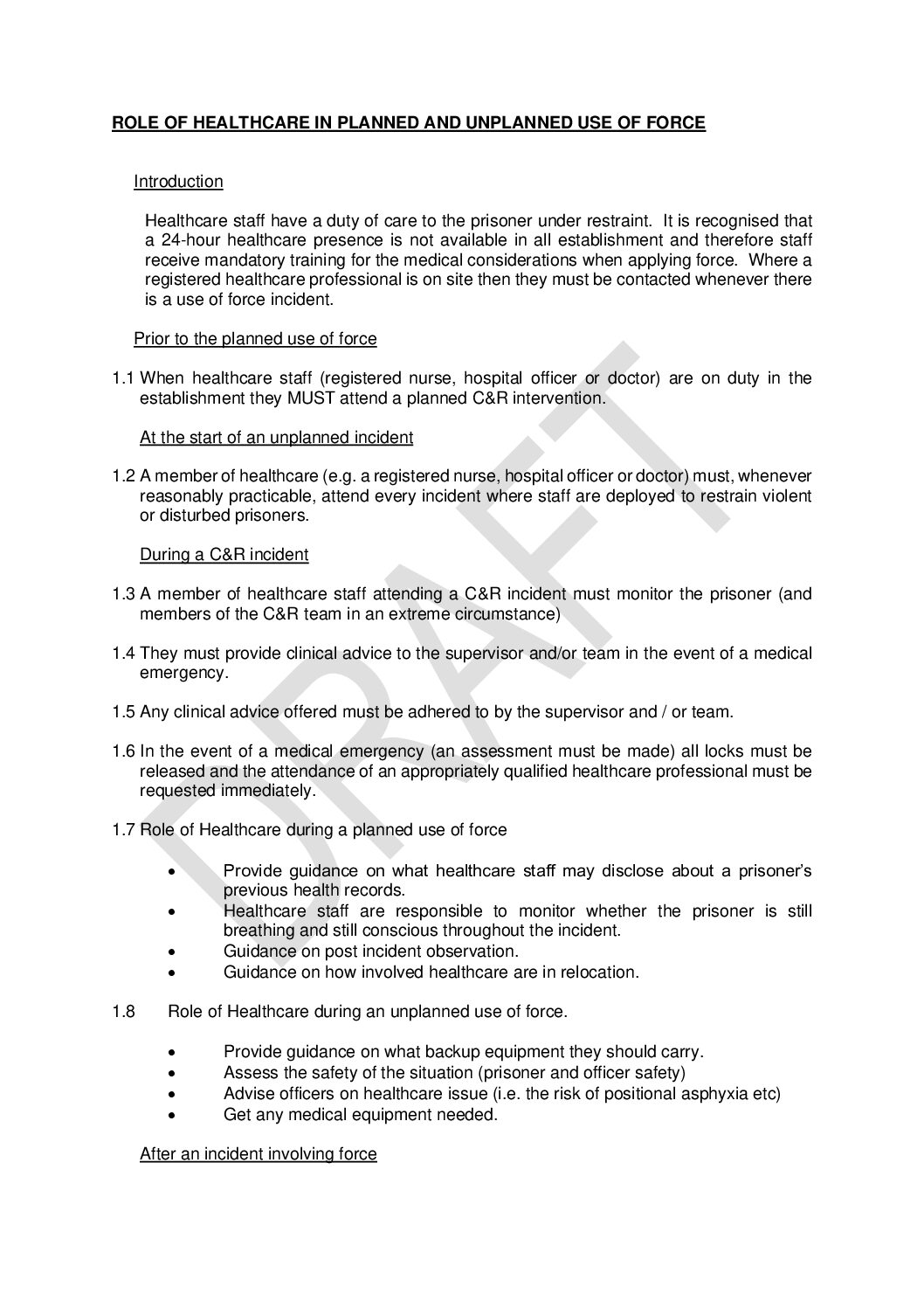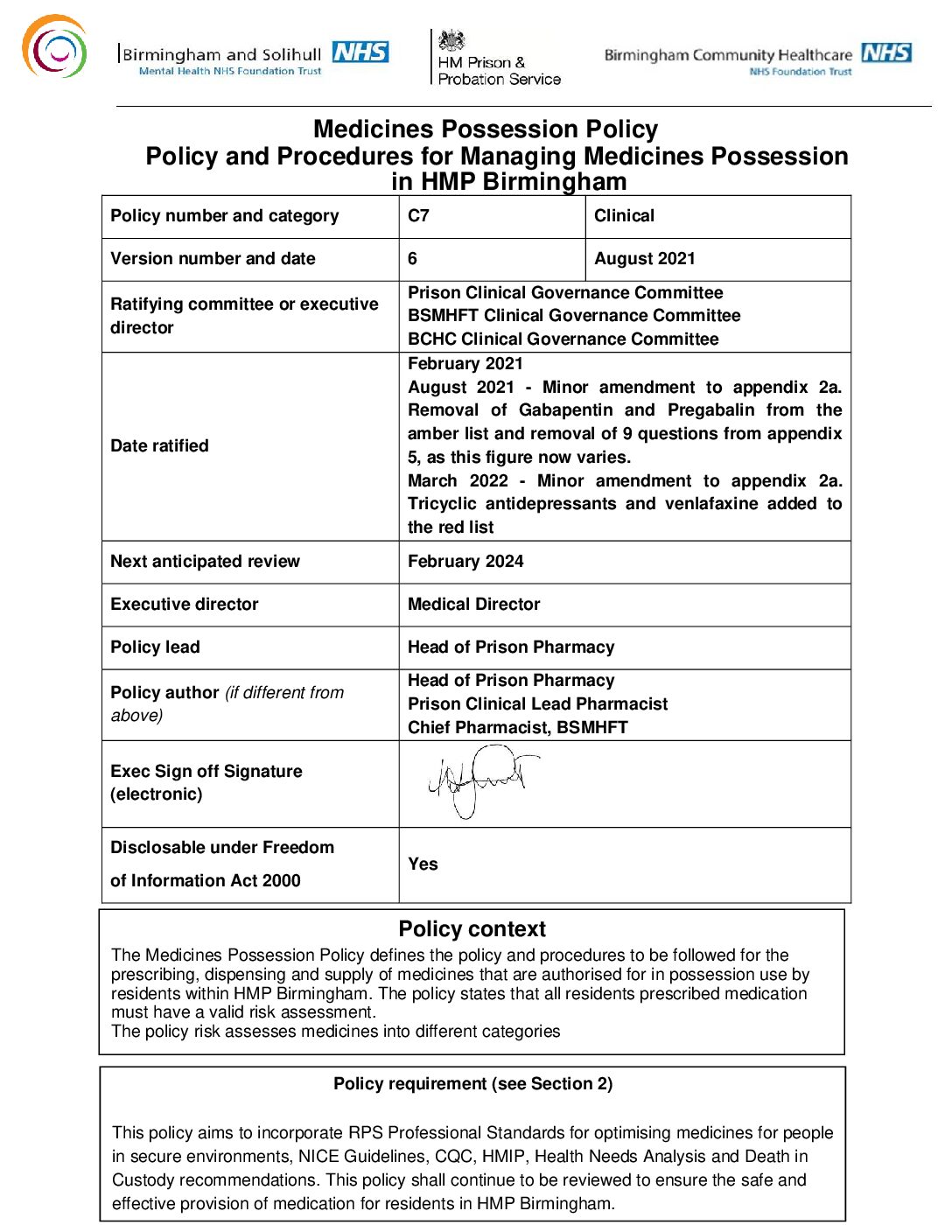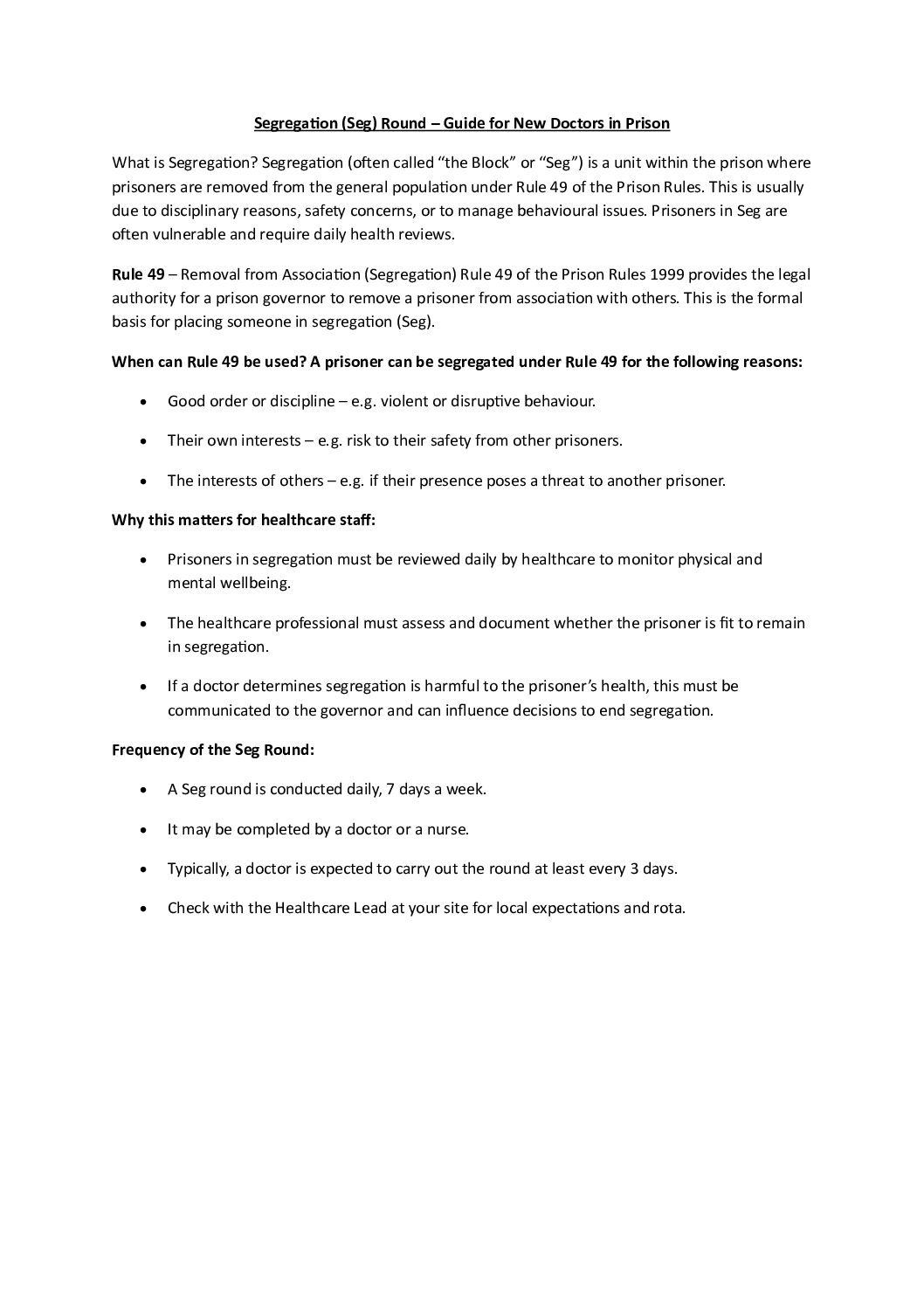Healthcare in Secure Settings
This resource outlines common challenges faced by healthcare professionals working in secure environments such as prisons and other secure facilities. Understanding these unique contexts is essential for providing effective, compassionate care while navigating security requirements and operational constraints.
Click on each challenge to expand and learn more about protocols, considerations, and best practices.
| Image | Title | Date | Summary | Categories | Link | hf:doc_categories |
|---|---|---|---|---|---|---|
| Role Of Healthcare in Planned and Unplanned Use of Force | April 11, 2025 | Healthcare staff have a duty of care to the prisoner under restraint. It is recognised … | All, Common Scenarios | all common-scenarios | ||
| Medicines Possession Policy | April 11, 2025 | The Medicines Possession Policy defines the policy and procedures to be followed for the prescribing, … | All, Common Scenarios | all common-scenarios | ||
| Segregation Guide | April 7, 2025 | Segregation (often called “the Block” or “Seg”) is a unit within the prison where prisoners … | All, Common Scenarios | all common-scenarios | ||
| RCGP Top tips for Healthcare staff starting out in prisons | April 1, 2025 | It is rewarding and demanding work, providing healthcare in a prison setting. Primary care, substance … | All, Common Scenarios | all common-scenarios |
Common Challenges
This relates to Prisoners who are arriving into the Prison (or secure estate). They may be returning to prison from court or they may be transferring to a new prison or starting a new sentence at the new prison. The role of healthcare is to review the new prison and assess their physical or mental needs prior to going to the cell, and ensure appropriate escalation, referrals and prescribing are undertaken. First night prescribing also involves ensuring recognition and treatment for Alcohol, Benzodiazepines and illicit Opiate use, as well as continuing prescriptions for critical meds including methadone.
“Escorts”: this term relates the requirement of Officers to escort Prisons when they are travelling outside of the prison. Examples of this in the healthcare are the attendance to Accident and Emergency or for appointments at the hospital for investigations (Imaging) or Consultant Specialist reviews.
“SEG” is an abbreviation for Segregation Unit and also relates to CSU or CSRU, where prisoners are isolated from the general population, often for safety, discipline, or the prisoner's own protection, with procedures and reviews to ensure its appropriate and limited us. Under Prison Rule 45, segregation may only be applied in the interest of: (1) good order or discipline, or (2) a prisoner's own interests, e.g. for a prisoner's own protection or behaviour is likely to be so disruptive or actually cause disruption to the extent that keeping them on ordinary location is unsafe.
It is a legal requirement for a Healthcare member to attend SEG every day and a GP to attend every 3 days. Healthcare will also attend SEG to review patients if they are asked to by the officers due to clinical need. The purpose of the SEG visit from healthcare is the address acute clinical need of the prisoner and may involve a physical and/or mental health assessment depending on requirement of the encounter. It is noted that the SEG environment is neither private nor clinical, and this must be a consideration. Patients with less acute needs must be encourage to access healthcare in the normal manner (using healthcare application form), so as to maintain equity of access with other non SEG patients. Whilst certainly more operationally challenging, it may be possible (and more appropriate) for the prison to come to the Healthcare department for healthcare appointments.
This is a common term used in the Secure estate. It refers to the observation from a member of staff that the resident is “under the influence” of an illicit substance or drug. This may be noted following a code (when a healthcare member is alerted to a healthcare need on the “wings” by means of a radio alert code being called) or when it is noted by a healthcare member of staff at medication administration.
The presentation will vary depending on the drug having been ingested or inhaled and it is important to note may or may not actually relate to the intake of a drug (in that there may be other reason a patient may be hyper-stimulated or sedate for other reasons). It is also relevant that it may not be confirm to use of drugs using a Urine drug screen, as the drug itself may not be tested on the drug screen, or the patient may not provide a urine sample for testing.
The identification or suspicion of a resident who is under the influence will prompt the healthcare team to make initial assessment and a period of monitoring, as defined by a policy of the Healthcare provider. It will usually also involve their medication (particularly opiate substitution therapy but also other medication) being withheld due to the risk of interactions with their prescribed medication and/or cardiovascular/respiratory depression or compromise). The identification of an individual who is under the influence will also prompt a review by Security (“the officers”) and also the ISMS team, as well as broader healthcare team in the less acute term (a review of underlying cause and prescribing).
Trading/ diversion of medications whereby prisoners may sell/divert high risk medication, such as Tramadol & Pregabalin, into the illicit prison economy presenting a significant risk of harm to both staff and prisoners who have to respond to the side effects, bullying and/or in some cases, overdose scenarios. Each Healthcare provider will have an agreed process for dealing with this situation. It will usually involve a communication of the event via incident reporting system and on the healthcare records, with a task being sent to the prescriber for review or other action. The Outcome from a suspected or confirmed medication diversion will depend on the medication being diverted, the current medications being used and previous encounters and/or episodes of diversion. The decision may be taken unilaterally or as part of multi-disciplinary approach depending on the complexity of the situation.
This relates to non-compliance of medication by the prison. The prison can choose not to take medication and this should prompt a review of the patient to understand reasons for this. This may include site operational challenges or personal situational issues, side effects, worsening physical or mental health, a balanced decision or capacity changes
NAV = No Access Visit
DNA = Did not attend
These relate to missed clinical appointments. There are multiple steps that are required to ensure a prisoners/patient’s arrival into the healthcare consultation room for an appointment. It cannot always be assumed that the missed appointment is the choice or fault of the prisoner/patient. With this in mind it is important to establish when a patient does not attend for an appointment if
1. the patient who has decided not to attend
2. the patient was required to attend elsewhere and therefore not able to attend healthcare
3. the patient was not made aware of the appointment (example; no appointment slip produced or delivered to patient)
4. the patient was not able to attend due to a lockdown or other emergency/incident, staff shortage
5. another reason
Appropriate coding as DNA or NAV allows subsequent action to be decided such as rebooking appointment or not rebooking appointment. Additionally, it allows healthcare to understand patterns which may be prohibiting the delivery of healthcare and identify when action should be taken and what action (such as reviewing processes or escalation to the Operator)
When a person dies in prison custody the Prison and Probation Ombudsman (PPO) will investigate that person’s death, irrespective of how they died. It might be a natural cause death, a self-inflicted death, substance misuse death or other non-natural deaths (such as homicide).
The PPO independently investigates deaths in prison custody in England and Wales, and they will request NHS England (NHSE) or Health Inspectorate of Wales (HIW) to commission an independent clinical review that forms part of the PPO investigation.
A PPO Investigator will lead on the investigation from a prison perspective, and a Clinical Reviewer is appointed to lead on the investigation from a healthcare perspective. The overall objective of a clinical review is to determine whether the healthcare the person received in prison was equivalent to what they would have received in the community, but the process also allows to identify good practice and any areas for learning to improve clinical care provided within a prison setting.
There are three potential levels of a clinical review:
1. Level one - which is typically a desktop review of the records, conversations with interested parties (primarily the healthcare provider within the prison) and the PPO Investigator, producing an overall clinical review report.
2. Level two - includes all of those elements but will also include formal interviews which are conducted jointly by the PPO Investigator and the Clinical Reviewer.
3. Level three - a more complex review which includes the above methodology, but the findings are brought together and analysed by a multidisciplinary panel.
Deaths in Custody, including following contact with the police - A guide to the role of the Crown Prosecution Service | The Crown Prosecution Service
This relates to whether the medication prescribed for the prisoner is given to the patient to self-administer or whether the patient will have to attend daily to receive medication dose by dose at the specific time.
Possession status can be assessed by any member of the healthcare team and it is established by completing a template on the medical records system. The template will have a number of categories that inform the overall score. A score is attained and a possession status is given which will be:
1. In possession 1-day, 7-days, 28-days
2. Not in possession
The decision as to whether the medication in actually given in-possession will demand both on the outcome of the Possession status and the type of medication. As an example;
1. Controlled drugs are NOT given in possession (methadone or Subutex or ADHD medications)
2. Inhalers and Creams should always be given in possession
In UK secure settings like prisons, clearance refers to the level of security access granted to staff or individuals, based on background checks and risk assessments. It determines what areas they can access and what information they can handle.





